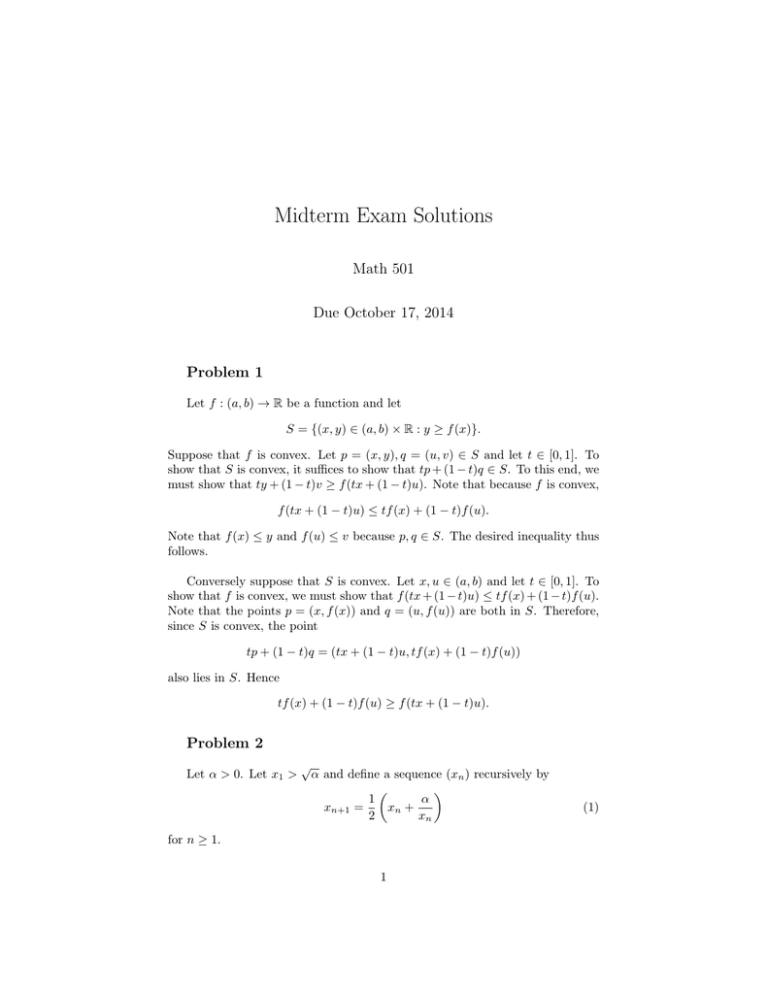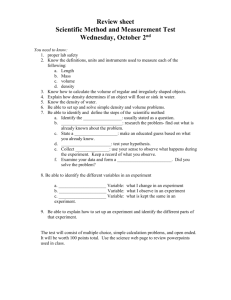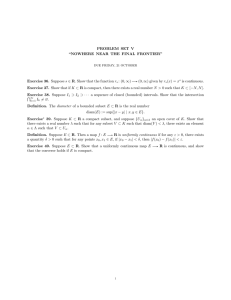Midterm Exam Solutions Math 501 Due October 17, 2014 Problem 1
advertisement

Midterm Exam Solutions
Math 501
Due October 17, 2014
Problem 1
Let f : (a, b) → R be a function and let
S = {(x, y) ∈ (a, b) × R : y ≥ f (x)}.
Suppose that f is convex. Let p = (x, y), q = (u, v) ∈ S and let t ∈ [0, 1]. To
show that S is convex, it suffices to show that tp + (1 − t)q ∈ S. To this end, we
must show that ty + (1 − t)v ≥ f (tx + (1 − t)u). Note that because f is convex,
f (tx + (1 − t)u) ≤ tf (x) + (1 − t)f (u).
Note that f (x) ≤ y and f (u) ≤ v because p, q ∈ S. The desired inequality thus
follows.
Conversely suppose that S is convex. Let x, u ∈ (a, b) and let t ∈ [0, 1]. To
show that f is convex, we must show that f (tx + (1 − t)u) ≤ tf (x) + (1 − t)f (u).
Note that the points p = (x, f (x)) and q = (u, f (u)) are both in S. Therefore,
since S is convex, the point
tp + (1 − t)q = (tx + (1 − t)u, tf (x) + (1 − t)f (u))
also lies in S. Hence
tf (x) + (1 − t)f (u) ≥ f (tx + (1 − t)u).
Problem 2
Let α > 0. Let x1 >
√
α and define a sequence (xn ) recursively by
α
1
xn +
xn+1 =
2
xn
for n ≥ 1.
1
(1)
(a) Let x, y > 0. Observe that (x − y)2 ≥ 0. Multiplying out the left hand side
and rearranging gives
2xy ≤ x2 + y 2
Adding 2xy to both sides of this inequality gives
4xy ≤ x2 + y 2 + 2xy = (x + y)2 .
√
Taking the square root of both sides shows that 2 xy ≤ x + y.
(b) Observe that for any n ≥ 1
xn+1 =
1
2
√
α
xn +
≥ α
xn
by the previous part. Therefore the sequence (xn ) is bounded below by
√
α.
(c) Observe that
1 α
− xn
2 xn
√
√
Therefore since xn ≥ α, we have that α/xn ≤ α and hence α/xn − xn ≤
0. It follows that xn is decreasing.
xn+1 − xn =
1
2
xn +
α
xn
− xn =
(d) We’ve shown that any decreasing sequence that is bounded below must
converge.
(e) Let L = lim xn . Taking the limit of both sides as n → ∞ in (1) gives
1
α
L=
L+
.
2
L
√
Solving this equation for L shows that L = α.
Problem 3
Let S ⊂ M . Recall that the distance to S was defined as
dist(p, S) = inf{d(p, s) : s ∈ S}.
(a) Let p, q ∈ M . Observe that for any s ∈ S
d(p, s) ≤ d(p, q) + d(q, s),
which implies
d(p, s) − d(q, s) ≤ d(p, q).
Taking the infimum over all s ∈ S of both sides above shows that
dist(p, S) − dist(q, S) ≤ d(p, q).
2
Interchanging the roles of p and q in the argument above gives d(q, S) −
d(p, S) ≤ d(p, q). It follows that
| dist(p, S) − dist(q, S)| ≤ d(p, q).
(b) Let f : M → R be given by f (p) = dist(p, S). Let > 0 and let δ = .
Suppose that p, q ∈ M satisfy d(p, q) < δ. Then observe that by the previous
part
|f (p) − f (q)| ≤ d(p, q) < δ = .
It follows that f is uniformly continuous.
Problem 4
(a) Let fn , f ∈ C[a, b] and suppose that fn → f in Cmax . Let > 0. Then
there exists N such that
sup{|fn (x) − f (x)| : x ∈ [a, b]} <
b−a
for all n ≥ N . Observe that for n ≥ N
Z b
|fn (x)−f (x)| dx ≤ sup{|fn (x)−f (x)| : x ∈ [a, b]}(b−a) <
a
(b−a) = .
b−a
Thus fn → f in Cint .
(b) Let fn (x) = (x − a)n /(b − a)n and let f (x) = 0 for all x ∈ [a, b]. Observe
that
Z b
|b − a|
→0
d1 (fn , f ) =
|fn (x)| dx =
n+1
a
as n → ∞. Thus fn → f in Cint . On the other hand
d∞ (fn , f ) = sup{|fn (x)| : x ∈ [a, b]} = 1
for all n ≥ 1. Thus fn does not converge to f in Cmax .
Problem 5
Let f : M → N be a continuous bijection and suppose M is covering compact.
(a) Let C ⊂ M be closed. Let A be an open cover of C. Note that A0 =
A ∪ {M \ C} is an open cover of M . Since M is covering compact, A0
reduces to a finite subcover B 0 . If B 0 does not contain M \ C, then let
B = B 0 and note that B is a reduction of A and covers C since it covers M .
If B 0 does contain M \ C, then let B = B 0 \ {M \ C}. Note here that B is
again a reduction of A and must cover C. Thus in either case, we’ve shown
that A can be reduced to a finite subcover.
3
(b) Let C ⊂ M be closed. The previous part shows that C is compact. Since f
is continuous, it follows that f (C) is compact. Note that compact sets are
always closed. Hence f (C) is closed.
(c) Let g = f −1 . Note that to show that g is continuous it suffices to show that
g −1 (C) is closed for all closed subsets C ⊂ M . Suppose C ⊂ M is closed.
Then g −1 (C) = f (C) is closed by the previous part.
(d) The function f was assumed to continuous and bijective. Thus to show that
f is a homeomorphism amounts to showing that f −1 is continuous, which
was shown in the previous part.
Problem 6
(a) Let M be connected and f : M → R be continuous. Consider the function
h : M → M × R given by
h(p) = (p, f (p)).
Note that h(M ) = Γ. Thus to show that Γ is connected, it suffices to show
that h is continuous.
Suppose (pn ) ⊂ M is a sequence and pn → p for some p ∈ M . Note that
f (pn ) → f (p) since f is continuous. Now observe that
h(pn ) = (pn , f (pn )) → (p, f (p)) = h(p).
It follows that h is continuous.
(b) Consider the function f : [0, 1] → R given by
x ∈ (0, 1],
sin x1
f (x) =
0
x=0
As above, let h : [0, 1] → [0, 1] × R be given by h(x) = (x, f (x)). Recall that
h((0, 1]) is connected because it is path connected. Moreover, recall that if
T is a set such that
h((0, 1]) ⊆ T ⊆ h((0, 1])
then the connectedness of h((0, 1]) implies that T is connected. Note that
the graph T of f is precisely
T = h([0, 1]) = {(0, 0)} ∪ h((0, 1]),
which contains h((0, 1]) and is a subset of
h((0, 1]) = {0} × [−1, 1] ∪ h((0, 1]).
It follows that Γ is connected, the domain of f is connected, but f is not
continuous at 0.
4





